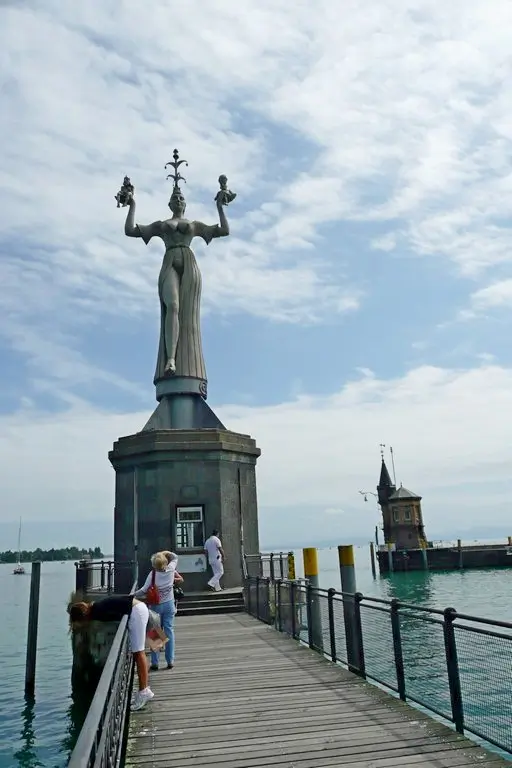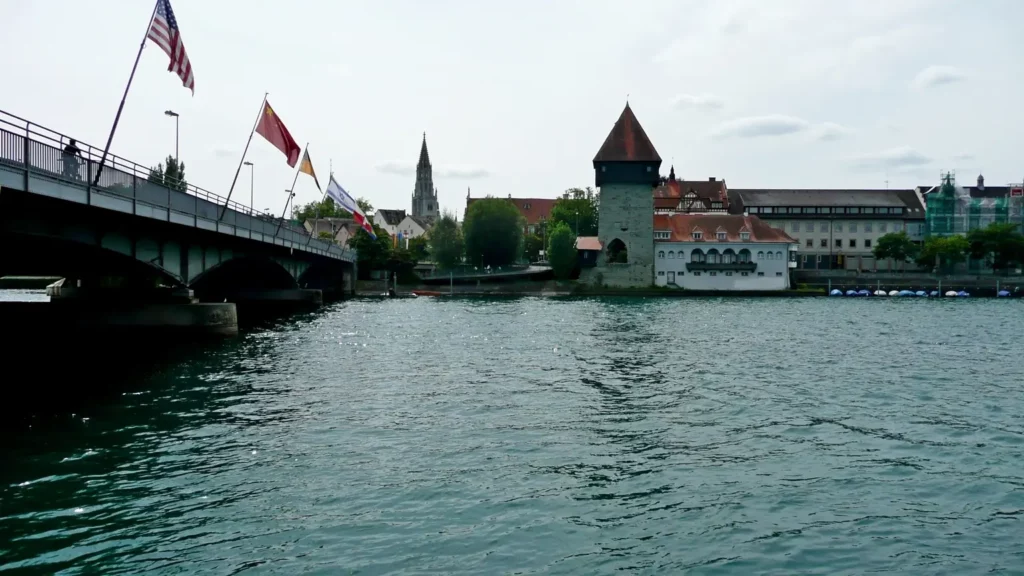Last Updated on 13/09/2024
Konstanz is very known, and it is usually included in the tourist program. But in reality, it is just the first candidate for deletion from the program if there is not enough time (and there are so many sights on the lake that there is hardly enough time).

Public transport around Lake Constance
Tourist and guest cards of Lake Constance
Lake Constance family holidays
German side:
Lake Constance map of attractions
Meersburg attractions, Mainau Island of flowers, Lake Überlingen,
What to see in Lindau
Austrian side:
Vorarlberg attractions. From Bregenz to Ischgl
Swiss side:
Rhine Delta Bodensee, Appenzell attractions
Swiss side of Lake Constance
Sankt-Gallen, Stein am Rhein, Rhine Falls
Konstanz
A little history
People settled here already in the Stone Age. The importance of the city determined its position. The shores here narrow, dividing the two parts of Lake Constance. In 100 A.D. came the Romans. They gave the city its name – Constantia in honor of the emperor Constantius Chlorus, who defeated the Alemanni in the region.
Since the 6th century, the seat of the bishop was founded in Konstanz. And in the Middle Ages the city had an important religious significance. In the Middle Ages, Konstanz was the only bridge across the Rhine in the region. So the city flourished and trade developed. In the 12th century, Constance received the status of an imperial city.
In 1415 Jan Hus was burnt here. During the Reformation, Konstanz temporarily became Protestant, and the bishop moved to Meersburg. But Catholicism returned with the arrival of the Habsburgs. Under the Austrians, the College of Jesus was founded in 1604. A theater was opened with it – it is the oldest theater in Germany, which still gives performances.
In the 19th century, Constance became part of the Grand Duchy of Baden, and later became part of the German Empire. During World War II, the city was not bombed due to its proximity to Switzerland.
How to get to Konstanz
Public transport.
The train stops at Konstanz. But it is easier to get from the opposite bank by ships.
From Meersburg, a cheaper option is by ferry, then by bus.
Walking around the peninsula instead of the bus is also accessible by distance.
Car – ferry from Meersburg.
Sights
The city is divided into two parts by the Rhine (or Lake Rhine).
The southern smaller one borders on the Swiss city of Kreuzlingen. There is an old town, a railway station, an aquarium of the Sea Life network (too high cost).
In the north path – residential areas, a university. The Therme are located in the northern part, at the very end of the peninsula jutting into Lake Constance, and there is also a public beach there.

What can you see?
The Cathedral of the Virgin Mary is a must. It was first mentioned in 615. The building was destroyed in the 11th century and was rebuilt over the next 300 years.
Take a look at the gallery of the courtyard, where ancient paintings have been preserved. You need to walk along the left nave to the very end and enter a small door. There will be another modest door leading to the cloister.



The tower overlooks the bay and the city, but the view cannot be called stunning.


In addition to the cathedral, the Dominican monastery has survived. Here Jan Hus was awaiting his execution. Now there is a hotel.
Several old towers have also survived, one of them near the bridge over the Rhine.

But in general, the city is not very interesting.



Follow me
On the second Saturday in August, the lake festival is held in Konstanz / Kreuzlingen. By this day, new crowds are added to the already existing and it is almost impossible to find a free room.
The holiday ends with a grand fireworks display. By the way, the fireworks can be seen from Hagnau and Meersburg. The smartest take their places on the hill. But you can try to knock around in the city. Do not forget that you can return by ferry (it runs all night once an hour), and then by bus (the last in both directions at 22.20) or railway with a transfer. In addition, by the time of the fireworks, boats arrive at the Konstanz harbor. Tickets can be purchased for this evening lake cruise with food and music.
From Konstanz you can also go to the Affenbach amusement park. It is between Konstanz and Radolfzell (by train + foot / bus). See other sights on the attractions map.
Reichenau Island
Not far from Konstanz, in a smaller part of Lake Constance, called the Untersee, is the monastery island of Reichenau. In 2000, the island with all its contents was included in the UNESCO World Heritage List.
You can get here by bus 7372 from Konstanz or by the same bus from the Reichenau train stop. In addition, of course, by water transport, it can only take a long time. The island is best explored by bike.
The Benedictine monastery was founded as early as 724 by St. Pirmin and acquired great importance in the Middle Ages as a cultural center. Pilgrims stopped here on their way to Italy, including St. Methodius. Illustrated manuscripts were created, scientists, a school of book miniatures worked.
Later, due to a conflict with the equally influential monastery of St. Gall, located at the other end of Lake Constance, the monastery began to fade away and was subordinated to the monastery of St. Gall. After secularization in the 19th century the richest library of the monastery was transported to Munich and Karlsruhe.
The monastery consists of several churches. The main cathedral dedicated to Our Lady and St. Marco, located next to the harbor. There are also churches of St. George and St. Peter and Paul. The most ancient painting of the 10th century in Germany is in the church of St. George.
Lands on the island that are not part of the monastery are occupied by gardening farms. The climate of the island and the entire Lake Constance allows even southern fruits to be grown.
In my opinion, it is worth visiting the island if you are very interested in old churches, if you are by car and driving past, or if you are looking for a place to ride a bike in comfort and without elevation differences. In other cases, the efforts to get here may not pay off.
Map of attractions,
Meersburg, Mainau, Stein am Rhein, Rhine Falls
Do you enjoy the site without cookies? This means that I work for you at my own expense.
Perhaps you would like to support my work here.
Or change your cookie settings here. I don’t use personalized ads






